
The world we live in is faced with several challenges, threats and hazards that has affected the survival of man and other living things. One of such is environmental pollution. Environmental pollution has imposed severe and irreversible damage to the World. It is one of the challenges that had threatened life and created problems man is battling with today. Pollution can be of various types which include air pollution, water pollution, soil pollution, sound pollution etc. Pollution can result in destruction of habitats, death of living organisms, mutation, reduction in organism population, climate change, and other environmental crisis etc.
Urbanization, overpopulation, industrialization Agricultural operations and technological development has brought about degradation of the environment especially air, water and soil by producing and releasing hazardous waste such as plastics, agrochemical, heavy metals, nitrates, burning of fossil fuels, acid rain, oil spills and industrial toxins etc into the environment.
TYPES OF WASTE MATERIALS
Waste materials can be liquid waste or solid wastes. These wastes can broadly be classified into two types
Degradable and non degradable materials.
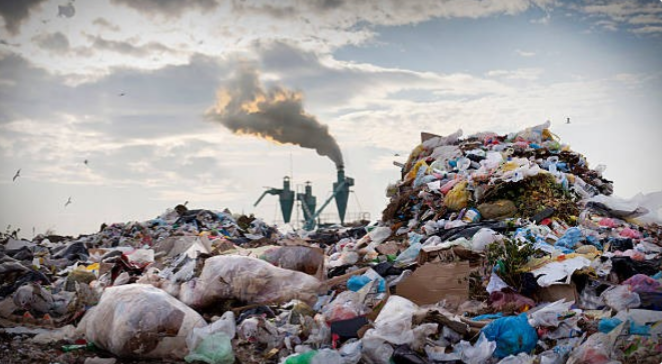
1. BIODEGRADABLE WASTE :
These are the wastes produced from man’s domestic activities and can easily decompose. They include wastes from kitchen such as food remains, garden waste, toilet wastes such as urine and faeces etc. They are atimes referred to liquid or moist waste. This can be composted to obtain manure. Biodegradable wastes decompose over a period of time depending on the material and converted into organic matter.
2. NON – BIODEGRADABLE WASTE
These are the wastes which include old newspapers, broken glass pieces, plastics, radioactive wastes etc. Non-biodegradable waste is known as solid or dry waste. Dry wastes can be recycled and can be reused. Non-biodegradable wastes do not decompose by themselves and hence are major pollutants.
METHODS USE FOR MANAGEMENT OF WASTE MATERIAL
1. BIODEGRADABLE MATERIALS: Some of the methods used to destroy degradable wastes include
chemical treatment, incineration, and burial in a landfill, Composting, Vermicomposting, use of latrines etc
2. NONBIODEGRADABLE MATERIALS: Some of the methods used for managing non degradable wastes include recycling, Bioremediation, land filling, burring in soil, chemical oxidation, flocculation, and pyrolysis etc
All or conventional techniques which are time-consuming, costly, and not environmentally friendly. Bioremediation technique has been applied to clean up oil spills, lagoons, rivers, groundwater, and soil instead of using conventional methods.
WHAT IS ENVIRONMENTAL POLLUTION?
Environmental pollution is any addition of erroneous substances or energies to the environment, that causes a change to the composition of the environment and causes harm to living organisms.
Pollution that affect the environment are caused through manmade activities. Some of this activities produce wastes which are harmful to man and other living organisms. Therefore, man seeks for ways to destroy these wastes generated. One of the methods used to get rid of the wastes is by releasing them into the environment. Thus, causing environmental pollution. Some of these wastes include: municipal waste, industrial waste and agricultural waste, household domestic wastes, and radioactive wastes etc. These wastes comprises of physical, chemical or biological substances. For examples : chemicals, pesticides, chemical fertilizers, heavy metals, non-degradable materials, bioaccumulation, fossil fuel, nutrients, biological agents, toxic substances, herbicides, refrigerants, polyaromatic hydrocarbons, petroleum oil, rubber, plastic waste, and many others. All are known as ‘Xenobiotics’. They all cause water, air and soil pollution. This pollutant causes a lot of health issues to man and other living things.
Science and technology had device a means of turning these substances to harmless, non- toxic material and can easily be cleansed from the environment. Thus, BIOREMEDIATION was developed.
WHAT IS BIOREMEDIATION?
Bioremediation is an environmentally friendly process that cleans and remove harmful contaminants which pollute soil, water, and air using microbes and plants to keep the environment safe.
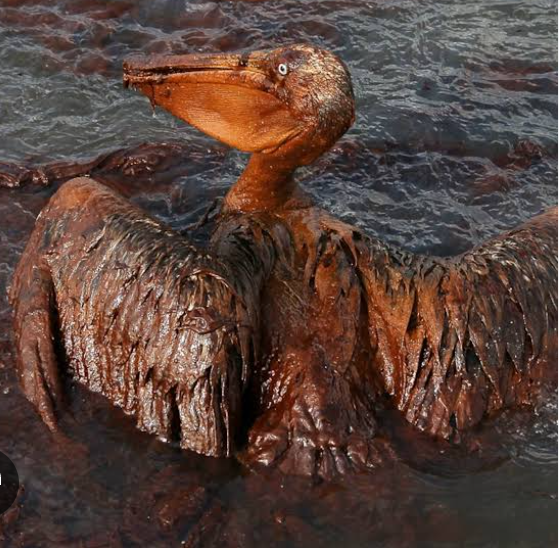
Bioremediation is a sustainable approach which can be employed along side other waste management methods such as physical and chemical treatment methods for complete management of diverse environmental pollutants. Living organisms, like microbes, microalgae, fungi , and bacteria(mycore- mediation) and plants ( phytoremediation) are introduced into where the contaminants, pollutants, and toxins are disposed and they assist in removal and cleansing of these harmful byproducts from the environments.
PRINCIPLE OF BIOREMEDIATION :
In Bioremediation, microorganism or plant used are native or indigenous to the contaminated site or exogenous or imported to the contaminated sites. These organisms assist in decomposition or break down and detoxify the harmful pollutants into simpler biodegradable products and produce clean fuel like CO2, H2O, and biomass. The Microorganisms uses the pollutants as their energy source and convert them into non toxic simpler forms.
ORGANISMS INVOLVED IN BIOREMEDIATION
1. BACTERIA : Major Bacterial species involved in bioremediation are Pseudomonas, Mycobacterium, Alcaligens, and Sphingomonas.
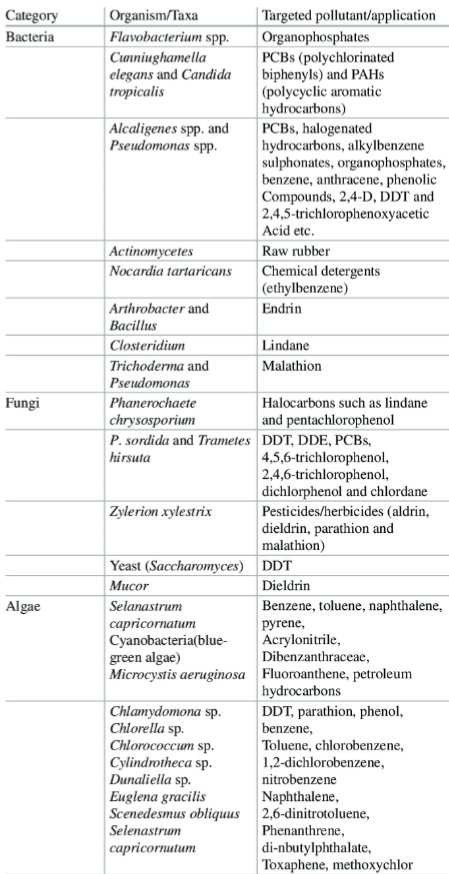
2. FUNGI: Fungal species involved in Bioremediation include Phanerochaete chrysosporium.
3. PLANTS: Some Plant species involved in Bioremediation, environmental areas and contaminated metals include;
a. Plants: Medicago sativa (alfalfa) Contaminated areas: Soil
Heavy Metals : Cd
b. Plants: Oryza sativa(rice). Contaminated areas: Soil.
Heavy Metals :Cu, Cd
c. Plants: Pistia stratiotes (water lettuce). Contaminated areas : water
Heavy Metals Cr, Cd, As
d. Plants: Pisum sativum (pea)
Contaminated areas Soil.
Heavy Metals : Pb, Cu, Zn, Fe, Cd, Ni,As, Cr.
e. Plants used for oil remediation include alfalfa (Medicago sativa ) and ryegrass (Lolium perenne ).

HOW BIOREMEDIATION WORKS
Bioremediation relies on stimulating the growth of certain microbes that utilize contaminants like oil, solvents, and pesticides for sources of food and energy. These microbes come in contact with contaminants such as oil, gas, or diesel in a suitable environment and convert the contaminants into small amounts of water, as well as harmless gases like carbon dioxide.
The process require an Ideal environmental conditions such as a temperature, surface pH, available moisture and other factors like nutrients, and foods. The absence of these elements may prolong the cleanup of contaminants.
To start the bioremediation process, Microbes secrete enzymes just like the human body produces saliva, stomach bile and other digestive enzymes to digest food. These enzymes break down the contaminants into smaller pieces. The microbes then consume the small pieces of the contaminants as a source of food and energy. After digestion of the contaminants, the microbes then release water, carbon dioxide, and other non-harmful amino acids as byproduct. Under suitable environmental condition, with ample food supply, the microbes multiply by reproducing and creating additional microbes to further aid in the removal of additional contaminants, and the cycle repeats until the food source is depleted.
FACTORS AFFECTING BIOREMEDIATION
1. Concentration of the contaminant
2. Nutrient availability
3. Surfactants
4. Characteristics of the contaminated soil. The contaminated soil has the following pH, texture, permeability, water holding capacity, temperature, and oxygen availability which are affected.
TYPES OF BIOREMEDIATION
There are two categories of Bioremediation. They include; In situ and Ex situ Bioremediation. These two categories are based on origin, transportation, and removal of pollutants from contaminated sites.
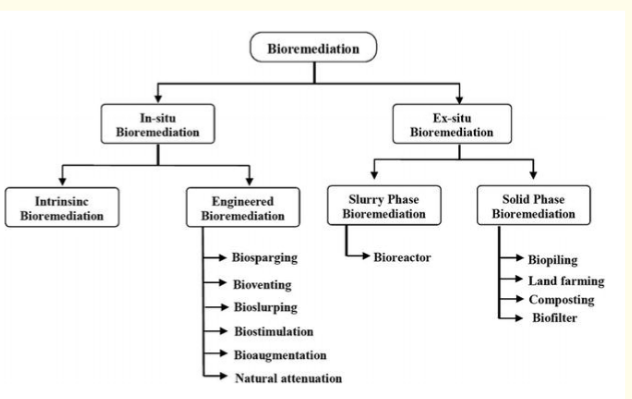
1. IN SITU BIOREMEDIATION:
This type of remediation is the most convenient, natural, and preferred method. It involves the remediation of contaminants at their native pollutant site without any transportation or excavation or disturbance. In situ, bioremediation is convenient, and cost-effective because no cost of extra transportation is involved but it is time-consuming and less controllable than the ex-situ remediation technique. This technique is further divided into two categories; Intrinsic and Enhanced.
1. INTRINSIC BIOREMEDIATION: it is also known as natural attenuation. This method involve passive remediation of harmful pollutants without any human involvement. The remediation is carried out by naturally occuring aerobic and anaerobic microorganisms indigenous to the site of a pollutant. It does not involve any engineering steps to enhance the process. And also the proceeds takes place without any disturbance but the progress of the decomposition is regularly monitored for sustainable and successful decomposition.
Intrinsic bioremediation is favoured by pH, concentration, temperature and nutrient availability. It is cost effective. And it takes longer time to complete the process.
2. ENHANCED BIOREMEDIATION: This type of in situ bioremediation involves the progress of remediation at polluted sites by excavation or the addition of nutrients, air, and microbes to enhance microbial growth for the biodegradation process. It is preferred than intrinsic bioremediation because it is completed in lesser time and it’s reliability.etc. The microorganism may be indigenous, but occasionally more efficient microorganism that degrade certain contaminant are added.
It is further categorized into several other types of In Situ Bioremediation Techniques which include bioaugmentation, bioventing, biostimulation, and biosparging
a. BIOSTIMULATION : As the name suggests this technique involves stimulation or enhancement of microbial activity by the addition of nutrients, cofactors, enzymes, and oxygen in adequate amounts. The added nutrients and electron acceptors like phosphorous, nitrogen, oxygen or carbon are sources of energy to the microbs rather than relying on the pollutants alone. This technique is used to treat heavy metal-contaminated sites petroleum and hydrocarbons polluted sites.

b. BIOAUGMENTATION : Bioaugmentation is the process of introducing a specific naturally occurring microbs with combination with a genetically engineered microbial strains inorder to enhance their capabilities in the contaminated sites to augment the natural degradation process. The introduction of the exogenous microbial species or genetically modified microorganisms to the contaminated site is to enhance the rate of biodegradation. But sometimes, exogenous microbes compete with indigenous microbes for nutrients. This technique is used to treat municipal wastewater or groundwater contaminated with chlorinated ethene
c. BIOVENTING : Bioventing is an in situ remediation technology that uses air (or oxygen) flow to stimulate indigenous microorganisms to biodegrade organic constituent in the soil with addition of nutrients. Low oxygen and low amount of nutrients are supplied through wells to promote the controlled growth of microorganisms at contaminated sites. These low oxygen reduce exposure of microbes in the soil to volatile contaminated chemicals in the environment. This technique is mostly used for the biodegradation of low-molecular-weight hydrocarbons, spilled petroleum oil or products, and volatile pollutants from the soil
d. BIOSLURPING : This process involves combination of multiple techniques to treat the contaminated sites like vacuum enhanced pumping, bioventing, and soil vapor extraction, for the removal of soil and groundwater pollutants by supplying oxygen indirectly and enhancing microbial biodegradation. But sometimes this technique reduces the permeability of soil. When oxygen is insufficient for the aerobic microorganism , this leads to a reduction in their activity.
e. BIOSPARGING : In biosparging, air is pumped under pressure beneath the water table for increasing groundwater oxygen concentrations, thus, boosting up the degradation of pollutants by indigenous microbes. The pressurized air pushes the volatile pollutants towards the topmost layer of soil for biodegradation by microbes present there. This process is dependent upon two factors; soil permeability and biodegradability of pollutants. But this technique is most suitable for volatile pollutants like benzene, xylene, and toluene.
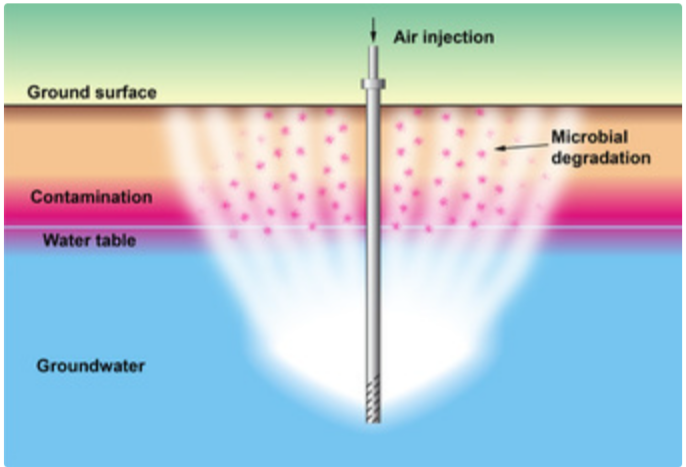
EX SITU BIOREMEDIATION :
Opposite to in situ, Ex situ bioremediation involves the excavation or transport of pollutants from their native contaminated site to the site where biodegradation is carried out. In contaminated surface water bodies like rivers, ex situ may not be the best option. But possible in underground water. Such groundwater can be pumped to the surface and captured in a reservoir where it is biologically treated.
Ex situ remediation is usually employed where the climate is too cold to sustain microbe activity, or areas with dense soil which prevent even distribution of nutrients. It is cost effective and involve transportation, location, and degree of pollution. Ex situ bioremediation techniques are classified into the following types; bioreactors, landfarming, biopilling, and biofilters.
1. BIOPILLING : Also known as the Heap technique. This involves excavation of the polluted soil and piling up the soil into a heap. nutrients ammendments are then added to the heap of polluted soil and sometimes aerated to enhance microbial activities (increase). Sometimes, additional exogenous microbes are also added. This technique is a combination of composting and landfarming. The technique is used to treat soil contaminated with low-molecular-weight (LMW) pollutants and petroleum hydrocarbons. The low molecular weight (LMW) pollutants are reduced and prevented from becoming volatilized. The technique is dependent upon pH, temperature, and nutrient control. And it is cost effective.
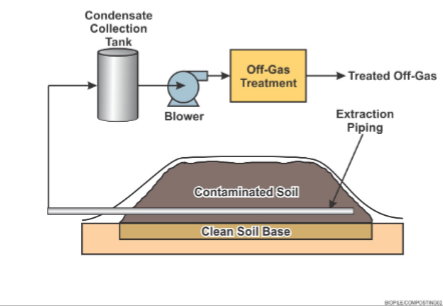
2. COMPOSTING
Composting is the process of degradation and decaying of organic waste. It occurs under favorable controlled conditions with the action of degrading microorganisms. The compost is a self-heating material made up of repetitive layers of plant residues and animal manure. The decomposition process carried out by microorganisms whose activities heat up the material until compost is eventually formed. The compost supply nutrient to the crops and plants for their effective growth and also improves the soil structure.
The steps involved in the process include sorting and separating, size reduction, and digestion of the refuse.
3. BIOREACTORS : Use of bioreactor vessels also called fermenter vessel which operates under controlled conditions to carry out remediation. Bioreactors is an engineered containers designed to carry out bioremediation of solid waste and underground water . The pollutants which may be in either dry or slurry form are fed into the bioreactor vessel for their degradation. This exsitu technique is dependent” on factors such as controlled bioaugmentation, supply of nutrients, mass transfer, availability of pollutants, and optimized reaction conditions.
4. BIOFILTERATION : Biofilters are one of the oldest bioremediation techniques.This is a biological treatment process which relies on biodegrading microbs population for degradation of pollutants which are organic contaminants in air and water. It is majorly used for contaminated air purification. The biofilter is composed of columns or media bed containing compost, soil or peat media with thin layers of microbes. The gaseous pollutant is passed through them and it gets biodegraded. It is majorly used to treat gaseous waste.
5. LAND FARMING
This technique involves the bioremediation of the polluted soil above ground. The contaminated soil is excavated and mixed with microbes, nutrients, and other amendments, followed by spreading over a prepared bed to facilitate aerobic degradation of contaminants. Soil is periodically tilled until remediated completely. It is a simple bioremediation technique, which can be operated both as in situ and exsitu
PHYTOREMEDIATION
This is a new advanced technique involving plants and their parts for the remediation of contaminated soil and groundwater. Plants possess an uptake mechanism for the absorption and clearance of contaminated material from the site. Roots uptake the pollutants along with water and minerals which are further translocated to shoots and leaves by the xylem and phloem. Phytoremediation methods potentially degrade, accumulate, immobilize, and transform contaminants by acting as a biofilter and metabolizing the pollutant. It is a cost-effective and innovative alternative method to conventional techniques.

ADVANTAGES OF BIOREMEDIATION :
1. PERMANENTLY ELIMINATE POLLUTANTS : pollutants are harmful contaminants therefore must be completely eliminated from the environment. This elimination process is carried out by microorganisms and plants as discussed above.
2. CAN BE COUPLED WITH THE PHYSICAL AND CHEMICAL CONVENTIONAL TECHNIQUES : Wide variety of biological, physical and chemical methods have been developed to decontaminate polluted sites. With bioremediation coupled with these conventional methods result into a complete wipe off of the contaminants.
3. NO OTHER ENVIRONMENT (SUCH AS AIR , WATER OR SOIL) IS CONTAMINATED DURING THE REMOVAL OF POLLUTANTS :. Any successful remediation technology should not simply transfer the contaminants to other environmental compartments even during transportion of the contaminants to other areas.
3. COST-EFFECTIVENESS : It is cheaper with minimal requirements of complex tools and equipment, as it is performed with microorganisms.
4. ENVIRONMENTALLY FRIENDLY : Environment friendly approach with use of microorganism and plants instead of using harmful chemicals. And it is only done where there is contaminants without causing any health issues.
5. INCREASE SOIL FERTILITY : .One of the main benefits of bioremediation is the ability to eliminate pollutants. With this, biological activity are increased and also soil diversity, this restores and maintain soil fertility on the long term.
6. PREVENT SOIL EROSION : When soils are contaminated, all lives on and within it die off. Plants which ought to cover the soil surface are distroyed exposing the land to erosion. But when pollutants are eliminated, plants and soil microbs build up on the soil, thus, preventing erosion.
7. Help in the recovery of precious metals.
DISADVANTAGES OF BIOREMEDIATION :
1. TIME-CONSUMING : Bioremediation processes takes a longer time to complete than other refinement methods.
2. NOT APPLICABLE TO RADIOACTIVE AND RECALCITRANT CHEMICALS : Radioactive and recalcitrant chemicals are highly dangerous. Microorganisms cannot decompose them.
3. Sometimes, microbes also produce toxic by-products by utilizing pollutants.
4. Require site-specific treatment.
5. TOXICITY TO PLANTS AND OTHER LIVING ORGANISMS : Heavy metals are those elements which have specific weight of more than 5 g cm3 . The metals that are at least 5 times denser than water are also defined as Heavy Metals. Heavy metals are either essential (Mo, Mn Cu, Ni, Fe, Zn) or non-essential metals (Cd, Ni, As, Hg, Pb). This means that some essential micronutrients when in excess are termed heavy metals. Therefore, these heavy metals pollutants can restrict the growth of plants, affecting the plant system, seed germination, production, physiological, biochemical, and genetic elements.
During bioremediation, the presence of volatile metals and metalloids such as Si, Hg, and As in the site may get volatilized into the atmosphere in their toxic form which may affect plants and other living organisms
6. ONLY LIMITED TO BIODEGRADABLE WASTE AND CONTAMINANTS : non biodegradable wastes like plastics, glass materials, nylon cannot be degraded by microbs. They can only be recycled to give another products
7. REQUIRES EXTENSIVE MONITORING : To determine the effectiveness and completeness of the remediation process to satisfactory level is one of the major problems. Therefore, monitoring practices is required for the determination of the disappearance of the contaminants and their degradation products to regulatory levels.

